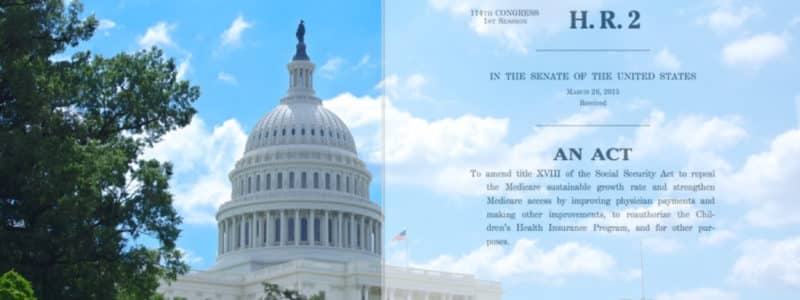Senate Action on the “Doc Fix”
On April 14, 2015 the Senate acted on a bill from the House of Representatives to implement a Medicare payment overhaul, including repealing the sustainable growth rate (SGR) formula, and updating other programs. Repealing or reforming the SGR was a goal of the medical community for seventeen years – virtually immediately after it was enacted. Year after year, applying the AGR formula to Medicare physician reimbursement would have resulted in large cuts in payments by Medicare for physician services, and year after year, at the last minute or later, Congress enacted a moratorium on application of the formula. Instead, there were sometimes freezes in payment rates and other times small across-the-board increases. But Congress could never agree on a comprehensive reform of the requirements of the SGR, so annual fixes were the order of the day. Enactment of the Medicare Access and CHIP Reauthorization Act of 2015 (MACRA) is the final “Doc fix”.
What is changed in the Medicare payment overhaul?
 Download the Entire MACRA in PDF Format
Download the Entire MACRA in PDF Format
The SGR formula is replaced with an initial 0.5% increase in Medicare payment rates as of July 1, 2015, followed by a four-year program of 0.5% annual increases, followed by a six-year freeze in payment rates.
There are also numerous changes to other Medicare payment regulations related to incentives and disincentives for adoption of electronic health records, quality measure reporting and other similar incentive programs. Several initiatives are now collapsed into a new Merit-Based Incentive Payment System – MIPS. Penalties that could be imposed under the Meaningful Use Incentive program and the Physician Quality Reporting System (PQRS) were repealed, and new incentives and disincentives enacted that roll these and other incentive programs into one overall rating system that also includes the previous Value-Based Payment incentives. Regulations implementing the methodology used to determine who is covered by MIPS and how the rating system will work must still be written, so stay tuned for more definitive information in the future.
Another feature of Medicare payment overhaul: alternative payment models
Physicians with a significant portion of their Medicare patients in non-managed care plans, e.g., enrolled in accountable care organizations, will be eligible for incentive payments of up to five percent of their Medicare reimbursement for such patients. This incentive system is designed to help CMS reach its goal of increasing the percentage of Medicare payments paid under alternative payment methods from 20% currently to 50% by 2018.
Other provisions of MACRA
The Medicare payment overhaul also covered several other issues in its 89 pages.
Global Surgical Packages
CMS had planned to eliminate the bundled payment for surgical services for 10 and 90 day periods following surgery. Instead, CMS will collect information on the types and volume of services provided in the global periods for potential changes to the reimbursement for surgery in the future.
Long-term Care Facilities Reimbursement
Medicare reimbursement for skilled nursing facilities and other post-acute providers such as home health agencies and LTCHs will be limited to a 1% increase for FY 2018.
CHIP
Funding for the Children’s Health Insurance Program is extended for another 2 years. The program was due to expire on September 30, 2015, and increased payments are also included in the extension. CHIP covers more than 8 million children and pregnant women. The funding for outreach to continue to find and enroll eligible children was also extended for 2 years.
Medigap Plans and Premiums for Part B and Part D
Most carriers providing “Medigap” plans, which cover things like deductibles and copayments due from Medicare beneficiaries, offer plans that cover the deductibles for hospital services (Part A) and for physician services (Part B). In 2020, carriers can no longer offer plans that cover the Part B deductible, currently $147 per year. Carriers can still offer plans that cover the Part A deductible.
Starting in 2018, the percentage of the cost of Part B and Part D plans that high-income beneficiaries ($133.5k modified adjusted gross income (MAGI) for an individual) must pay would be raised from 50% to 65%. For individual beneficiaries with MAGI over $160k, the percentage would be 80%.
Other Federal Programs
Several other federal programs were extended through FY 2017. These range form the Community Health Center program and the National Health Service Corps to the Personal Responsibility Education Program and the Maternal, Infant and Early Childhood Home Visiting Program. Many of these programs are used to fund grants for potential beneficiaries, but some are also integral to the ongoing operation of facilities such as federally funded health centers.
It’s called Medicare payment overhaul, but it actually has 39 separate sections. You can download a short section by section summary of the act to get a good overview. It will be months and possibly even years before all the provisions are implemented with regulations, but it certainly did finally address a long-festering source of so munch angst in the provider community: the SGR!

